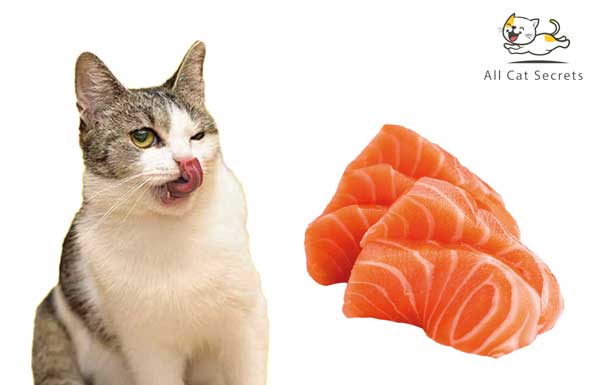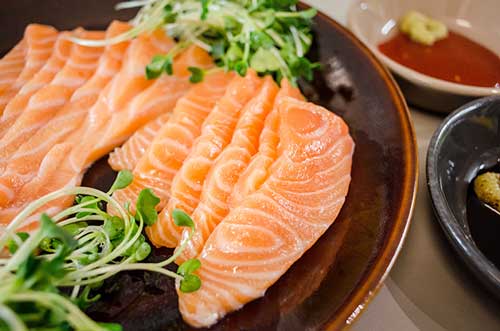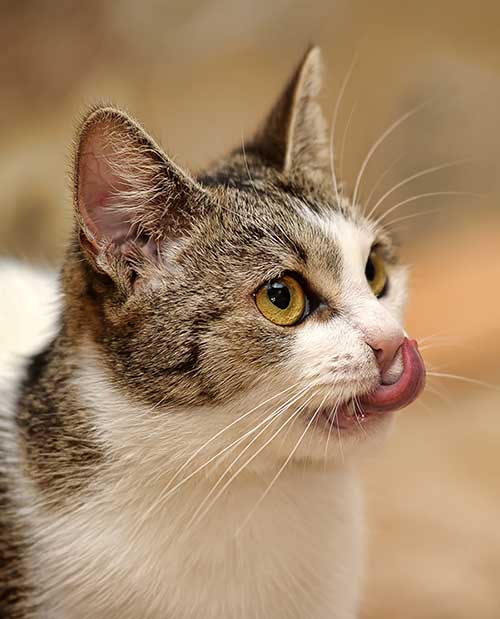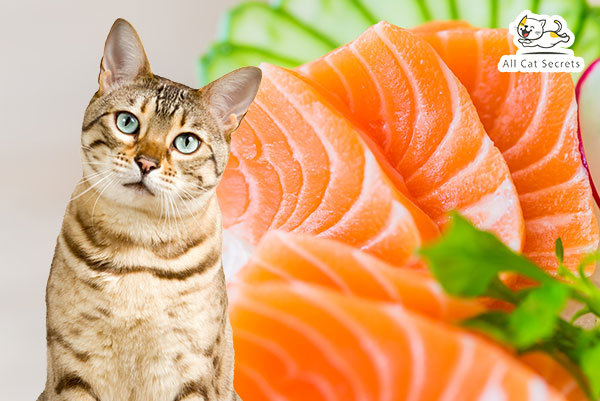Cats have a deep love for various types of meat, ranging from beef and pork to poultry and seafood. In fact, the housecat is one of the few pets whose primary diet should comprise meat. That’s because all cats, wild and domestic, are considered obligate carnivores.
Another interesting dietary fact about housecats is that these animals can eat both raw and cooked meat. Provided that the food is relatively warm, your feline friend will enjoy it raw or cooked.
Based on the above facts, it’s understandable why many pet owners would readily share slices of sashimi with their cats. But can cats eat sashimi?
While cats can eat sashimi, they probably shouldn’t. The main problem with sashimi for cats is that it’s raw meat, and might be laced with harmful bacteria.
Although cats have been eating raw meat from the beginning of time, uncooked meat presents numerous risks. That’s especially true if the meat has been improperly handled.
Read on as we share some insights into the possible effects of sashimi on cats.
Table of Contents
What Is Sashimi?
If you’re a cat owner who also happen to love sashimi, you’ll occasionally find yourself wondering, is sashimi OK for cats?
We’ve just mentioned that sashimi isn’t good for cats. But before we delve deeper into the possible adverse effects of sashimi on your feline friend, it would be best to understand what this food is all about.
Sashimi is a Japanese delicacy made of fresh raw fish or other meat, carefully sliced into thin pieces and commonly eaten with soy sauce.
Sashimi is usually the first course in a Japanese meal. However, it can also be the main course. When eaten as the main course, sashimi is commonly presented alongside rice or miso soup.
In addition to the sliced meat and sauce, sashimi dishes also usually include a variety of condiments. Popular ones include wasabi paste, grated fresh garlic, and grated fresh ginger.
Now, the words “sashimi” and “sushi” are commonly used interchangeably by non-Japanese chefs. However, these dishes are quite distinct from each other.
Sushi is basically a dish made using vinegared rice. Although the meal can also include raw fish, many sushi recipes use cooked seafood. In fact, several sushi dishes are prepared with no seafood at all. On the contrary, raw seafood is the primary sashimi ingredient.

Why Is Sashimi Discouraged For Cats?
The biggest issue with sashimi for cats is that it’s raw meat.
We began by mentioning that cats can eat both cooked and uncooked meat. However, raw meat is only safe for cats if naturally sourced and freshly eaten.
While your cat can safely eat a freshly-killed mouse, the same cannot be said about raw meat that has been sitting in your refrigerator for weeks.
The following are the specific issues with feeding raw meat to cats;
1. Pathogens
Raw-meat foods like sashimi are normally contaminated with disease-causing bacteria. Common pathogens in uncooked meat include Salmonella, E.coli, Campylobacter, Listeria monocytogenes, and Toxoplasmosis.
Although a cat’s stomach contains powerful digestive juices that can kill many of these pathogens, some could still survive and cause disease.
The side effects of raw meat in cats mainly depend on the types of bacteria ingested. However, most cats will present symptoms of gastrointestinal distress, including nausea, vomiting, appetite loss, diarrhea, flatulence, and abdominal pain.
Note that the diseases resulting from eating raw meat, such as salmonellosis, can be fatal if untreated. That’s especially if your cat has helped himself to high quantities of uncooked meat. The worst part is that the potential side effects of raw meat for cats can spiral over to the other household members, including humans.

After ingesting raw meat infested with disease-causing bacteria, your cat may shed these pathogens in their feces or saliva. When that happens, anyone who comes into contact with the cat’s excrement can become infected.
Cross-contamination can occur when you inadvertently touch your cat’s poop while cleaning his litter box or get smeared with his saliva during regular grooming or petting sessions. Without proper handwashing, you could contaminate food and other objects like utensils and furniture, thereby exposing everyone else to the risks of bacterial infection.
2. Heavy Metals
Certain types of raw meat, particularly seafood, tend to be worryingly high in heavy metals like mercury and lead. Ingesting these metals can adversely affect your cat’s vital organs, including his brain, lungs, and kidneys.
The problem with heavy metals is usually a greater concern for larger fish, which are known to store dangerous levels of mercury. It’s even worse considering that most methods used in treating raw meat don’t completely eliminate these organ-damaging components from the meat.
- Cats Lose Their Cool: Temptations Creamy Puree Wet Cat Treats deliver irresistible tuna flavor in a squeezable, creamy puree your...
- Versatile Feeding Experience: Feed this lickable wet cat treat by hand for an interactive bonding experience, treat on its own in...
- Fewer Than 15 Calories Per Pouch: Feel good treating your cat because each pouch contains fewer than 15 calories.
Last update on 2024-07-11 / Affiliate links / Images from Amazon Product Advertising API
3. Nutritional Deficiency
The third problem with raw meat is that it tends to be nutritionally incomplete. This is another counterintuitive statement with regard to uncooked meat for cats. That’s because raw foods are generally known to contain more nutrients than cooked foods. However, this isn’t always the case.
Certain minerals, such as vitamin A, tend to be more abundant in cooked than raw foods. Besides, the housecat has lived with humans for thousands of years. Over that duration, these animals have adapted to eating cooked foods.
So, your cat’s body is likely to extract nutrients from cooked meat more efficiently than raw meat. The only requirement is that the meat should be prepared using methods that preserve most of its nutritional elements.
4. Thiaminase Poisoning
Raw meat, especially raw seafood, is usually high in an enzyme known as thiaminase.
Thiaminase is notorious for breaking down vitamin B1 (thiamin), an essential vitamin that all cats need.
Vitamin B1 deficiency might cause several neurological problems, including seizures and muscle spasticity.
5. Choking Risks
Last but not least, raw meat may present choking hazards.
Choking risks are rarely a concern when it comes to sashimi. That’s because most sashimi recipes generally use finely-chopped, boneless meat.
However, the risks of choking from sashimi are always there, considering that the meat used is still reasonably tough.

Are Cats Allergic to Sashimi?
Sashimi allergies in cats are generally unheard of. But that doesn’t make them entirely impossible.
There are several reasons why cats might develop allergic reactions to sashimi.
First, sashimi is inherently raw meat. And as we’ve mentioned above, uncooked meat can produce a host of negative reactions in cats. Although these side effects mainly present as symptoms of gastrointestinal distress, they could also manifest as hypersensitive reactions like skin rash, itching, labored breathing, and fever.
Secondly, remember that domestic cats are more adapted to eating cooked meat. Therefore, feeding them any raw meat diets like sashimi could cause allergic reactions.
Lastly, sashimi might trigger allergies in your cat if feeding this meat to your feline friend for the first time.
What of Other Ingredients in Sashimi?
Raw meat is bad enough for cats. But when it comes to sashimi, the risks go beyond the mere fact that the meat could be laden with pathogens and heavy metals.
Many sashimi recipes include vegetables and spices.
Cats can safely eat most veggies in moderation. However, these animals should generally avoid spices. That’s especially true for spices in the allium family, such as onions and garlic.
Exposure to garlic or onion could lead to a type of hemolytic anemia known as Heinz-body anemia. Heinz-body anemia causes anemia-like symptoms like pale gums, as well as fatigue, fever, seizures, and coma. If untreated, your cat could succumb to this condition.
Cream cheese is another common sashimi ingredient that cats shouldn’t eat. That’s for the simple reason that cheese is a dairy product; hence, contain lactose.
Note that adult cats are lactose-intolerant. A cat’s body gradually loses the ability to release lactase, the enzyme known to digest lactose. Common symptoms of lactose intolerance in cats include vomiting, diarrhea, and stomach upset.
- CONTAINS: This pack of Delectables Stew contains twelve (12) 1.4-ounce lickable cat treats.
- CATS LICKS THE BOWL CLEAN: These stew cat treats combine tender chicken or succulent fish with a hearty and rich sauce for a cat...
- TASTY TEXTURE FOR CAT TREATS: The meat and sauce are entangled in this tasty wet texture, ensuring your kitty eats the whole cat...
Last update on 2024-07-12 / Affiliate links / Images from Amazon Product Advertising API
Can kittens eat sashimi then?
Since lactose intolerance is more of an adult cat problem, you might be tempted to feed sashimi to your kittens. However, younger cats should equally avoid sashimi. Even if cheese may not be such a big problem for kittens, there are many other ingredients in sashimi that could prove toxic to them.
Can Cats Eat Processed Sashimi?
Sashimi may be processed to eliminate pathogens and heavy metals, as well as make the meat more nutritionally-dense and last longer.
But does that make processed sashimi healthy for cats?
Well, not necessarily. As with all processed foods, refined sashimi might contain lots of chemical additives in the form of preservatives and flavor enhancers.
Brine (concentrated sodium chloride) is a common preservative in processed human foods. This chemical is associated with sodium-ion poisoning in cats.
Sodium-ion poisoning is a serious condition that can trigger irreversible kidney and liver damage. The disease produces a range of kidney-related symptoms, including frequent thirst sensation and frequent urination.
Without treatment, this condition could lead to more severe complications, such as seizures, coma, and even death.

So, can cats with kidney disease eat sashimi? And what of diabetic cats, can diabetic cats eat sashimi?
Neither cats with kidney disease nor diabetic cats should eat sashimi. That’s especially true for processed sashimi, which might be laden with brine and other potentially toxic chemical additives.
In fact, sick cats should avoid sashimi altogether, due to their reduced immunity. The same logic is true for nursing cats and pregnant cats.
Does It Matter The Type Of Sashimi My Cat Eats?
Sashimi can be made from a variety of seafood and other meat products. But does the meat used make sashimi any safe for cats? Let’s find out.
Can cats have salmon sashimi?
If you’re fond of salmon sashimi and happen to own a cat, you’ll often find yourself wondering, can I feed my cat salmon sashimi?
But can cats eat raw salmon sashimi?
Salmon is safe and nutritious for cats. However, sashimi is inherently raw meat and that’s precisely what makes salmon sashimi potentially harmful to cats.
Can cats eat raw salmon?
The fact that cats shouldn’t eat raw meat makes raw salmon bad for your feline friend.
Can cats eat raw salmon skin?
Again, raw salmon skin is bad for cats for the simple reason that it’s raw and might be contaminated.
Can my cat eat tuna sashimi?
Tuna is another seafood considered safe and nutritionally beneficial for cats. But that only applies to regular tuna and not tuna sashimi.
Can cats eat octopus sashimi?
Cats may eat regular octopus meals. Unfortunately, octopus sashimi is bad for cats. It all has to do with the fact that octopus sashimi is raw meat and could be contaminated with pathogens.
Can cats eat yellowtail sashimi?
Yellowtail sashimi is another variety of sashimi that cats shouldn’t eat.
Can cats eat fresh raw fish?
Fresh raw fish may look palatable to a cat. But the fish could still harbor numerous parasites and heavy metals.
Can cats eat raw frozen fish?
Raw fish is bad for cats; fresh or frozen.
Can cats eat raw fish skin?
Even without delving deeper into the effects of fish skin for cats, the fact that it’s raw fish skin makes it potentially harmful for cats.
- 100% Complete and Balanced for Cats: Enriched with vitamins, minerals, and essential nutrients, this wet cat food provides 100%...
- Variety pack contains three delectably soft cat food entrées with the light texture and irresistible seafood flavor cats love
- Individual, easy peel trays mean that you’ll have zero messy leftovers, unlike canned cat food
Last update on 2024-07-12 / Affiliate links / Images from Amazon Product Advertising API
What Should I Do If My Cat Ate Raw Salmon?
The first thing to do if you discover that your cat has eaten raw salmon or any other raw meat is to establish the quantities consumed.
Next, watch out for any symptoms of gastrointestinal distress, particularly vomiting and diarrhea.
While you can mediate these symptoms through rehydration, it’s prudent to take your cat to the vet in severe cases.
Conclusion
Sashimi may be made from meat, which also happens to be a cat’s main diet. However, the fact that sashimi is raw meat makes it inherently bad for cats.
That’s mainly because raw meat usually harbors parasites and heavy metals. Even treated sashimi may still be harmful to your cat as it could contain chemical additives known to be toxic to felines, such as brine.
Checkout Our Favorite Cat Products
1. Best Online Course For Cat Parents
Our favorite: The Cat Language Bible (How to Finally Understand And Speak to Your Cat) – A new form of cat to human communication that many cat owners have dreamed about… but few have actually thought possible.
2. Best Immune Support For Cats
Our favorite: Tomlyn Immune Support – Best Supplement for Cats and Kittens.
3. Best Cat Treats
Our favorites: LIFE ESSENTIALS All Natural Freeze Dried Chicken And Sheba Meaty Tender Sticks – Both are Great.







